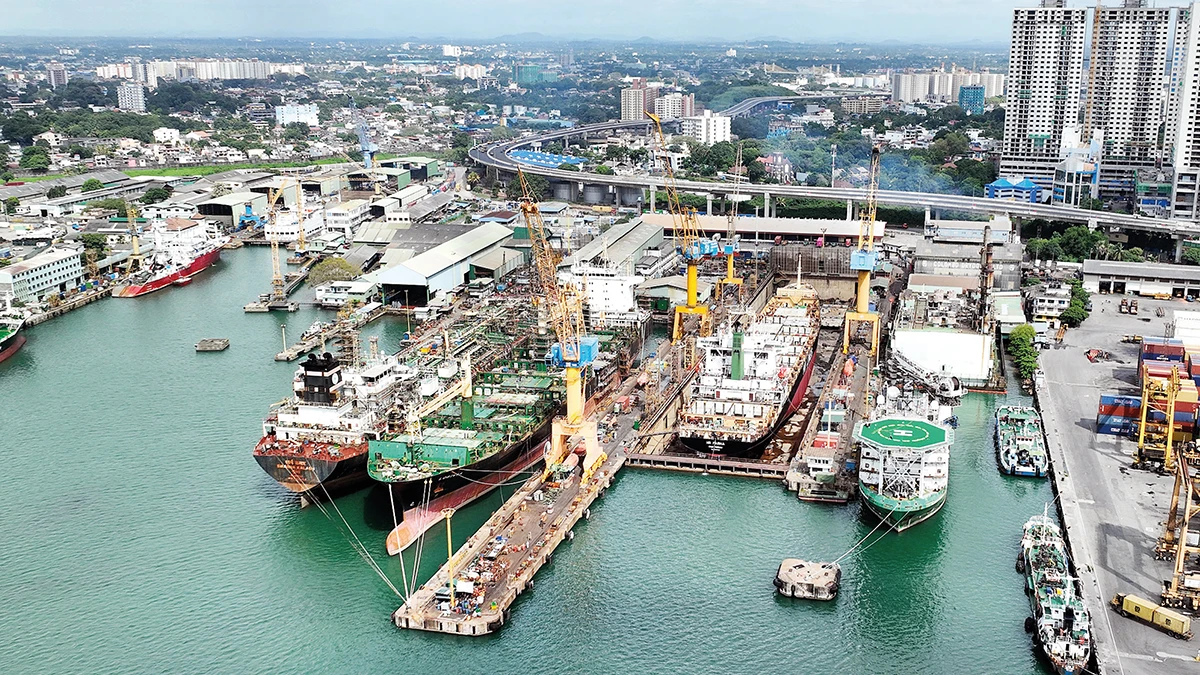One plus one is two. But not when India’s leading shipbuilder-a maker of submarines and warships-joins forces with Sri Lanka’s main shipbuilder.
In this case, the total is much more than the sum of its parts.
In June end, the board of the India government-owned Mazagon Dock Shipbuilders Limited okayed an investment of about 0450 crore to acquire at least 51 per cent privately owned existing shares of the publicly listed Colombo Dockyard PLC (CDPLC).
Analysts would be quick to compare notes with the nearby port of Hambantota, which was an opportunity squandered by India, allowing China to make inroads.
The CDPLC shares include that of the majority-stake-holding Japanese Onomichi Dockyard Co Ltd. One reason for the sell-out is the non-provision of Sri Lankan bank guarantees to the loss-making CDPLC.
With a pedigree in new builds and repairing, CDPLC lies within the strategically located Colombo port, which is just 76 nautical miles from major shipping lanes connecting the west, Middle East, the far east, Africa and Australia. This means there is tremendous scope for undertaking ship repairs, maintenance and overhauls.
With a current order book of more than $50 million and a pipeline order of $300 million, CDPLC fell into bad times during 2019 because of black swan events like the April 21 Easter bombings and the island nation’s economic crisis, followed by the pandemic.
“We see it as a robust business proposition that will unlock operational synergies by a cross-fertilisation of varied capabilities,” Biju George, director (shipbuilding), MDL, told THE WEEK.
Significantly, MDL was evaluated as the most suitable from about 40 interested buyers. “In about four months, MDL will assume managerial control and CDPLC will become a subsidiary,” said George. “We are primarily looking at it as a business-to-business deal aiming at enhancing and expanding our commercial shipbuilding and ship repairing capacity, although it has a government-to-government aspect, too. It will transform Mazdock from a domestic naval shipbuilder to a regional shipbuilder with global aspirations.”
Of course there are caveats. No foreign warships can be built or repaired at the port without approval by the Sri Lankan government.
At the strategic level, the move is path-breaking as it complements India’s SAGAR (Security and Growth for All in the Region) objective-a pet project of Prime Minister Narendra Modi. The SAGAR doctrine has a geopolitical dimension, too, in view of China’s growing footprint in the region.
Said Commodore R.S. Vasan (retd), director general of the Chennai Centre of China Studies: “It’s a wonderful win for both when the two sides can draw up plans for revamping the shipping-related industry. The possession of a huge dry dock that can take ships up to 1,25,000 DWT (dead-weight tonnage) confers flexibility options for all customers, including from India and other countries. At another level, there are certain gains from the fact that the Japanese were involved in this company and therefore some of the best practices would be adopted by the company.”
As it is, India’s vast maritime potential remains untapped in general and in shipbuilding in particular with just 0.06 per cent share in global shipbuilding.
“This is a great opportunity to resurrect the joint shipbuilding and repair options,” said Vasan. “That MDL and the Indian government are thinking globally and acting regionally is encouraging.”
If for India the latest foray into Lankan waters means more fuel to fire its growing maritime ambitions and adding strategic depth, for Sri Lanka it is about an economic turnaround, further nurturing of a traditionally vibrant maritime ecosystem and protection of the jobs of about 3,000 workers. But more than anything else, the move is being seen as a convergence of the visions of two South Asian nations in a very closely contested space.
A senior official connected with the Colombo dockyard said the new government under President Anura Kumara Dissanayake had actually requested the Indian government to encourage investments in the dockyard. “Our Colombo dockyard has been suffering huge losses for years now. MDL was shortlisted based on its financial strength and its track record in shipbuilding,” the official told THE WEEK on condition of anonymity. “It will generate revenue continuously. We believe MDL can route new construction contracts to Colombo. The revenue generation will happen through repair, refit and these construction contracts.”
When Dissanayake took over, it was felt that Sri Lanka-India relations had taken a back seat-the leftist government, it seemed, was leaning more towards China. This deal breaks that perception.
But there is also controversy. The Frontline Socialist Party (FLSP), a fringe group in Colombo, has raised concerns of foreign control, threat to national sovereignty and economic transparency. “This would strip the government of majority control over a strategically vital maritime institution,” Pubudu Jagoda, an FLSP office-bearer, told the local media.
The Sri Lankan government, however, said that the deal had only strengthened the country’s hold on the maritime route as India, a key neighbour, will not go against Sri Lanka. Said Eranga Gunasekara, Sri Lanka’s deputy minister of youth affairs: “The deal will address Sri Lanka’s long-term benefits, especially for workers and local industries connected to the port.”
Analysts would be quick to compare notes with the nearby port of Hambantota, which was an opportunity squandered by India, allowing China to make inroads. So, for many reasons, this long-term investment would pay rich dividends.
“For India to claim it is a maritime nation and to reclaim its past glory, it has to expand the scope of such outreach,” said Vasan.
In 2021, India ranked a lowly 21st in shipbuilding, but has ambitious plans to rank in the global top five by 2047. That is why the latest acquisition in Colombo may be in perfect alignment with the plan. “It can be the veritable force multiplier,” said George.
